新时代的中国国防(双语全文)
新华网 2019-07-24 13:54

五、合理适度的国防开支
V. Reasonable and Appropriate Defense Expenditure
中国坚持发展和安全兼顾、富国和强军统一,坚持国防建设与经济建设协调发展,坚持勤俭建军方针,依据国家经济发展水平和国防需求,合理确定国防费规模结构,依法管理和使用国防费。
China attends to both development and security. It is making an integrated effort to build a prosperous country and a strong military, and striving for the coordinated development of national defense and the economy. Following the principle of building the armed forces through diligence and thrift, China takes into consideration the development of the economy and the demands of national defense, decides on the appropriate scale and composition of defense expenditure, and manages and applies these funds in accordance with law.
改革开放以来,中国国防开支经历了从维持性投入到适度增长的发展历程,总体保持与国家经济和财政支出同步适度协调增长。国防费占国内生产总值(GDP)比重从1979年最高的5.43%下降到2017年的1.26%,近30年一直保持在2%以内。1979年国防费占国家财政支出比重为17.37%,2017年为5.14%,下降超过12个百分点,总体下降趋势明显。
Since reform and opening-up, China has increased its defense expenditure from a level of sustainability to moderate growth. On the whole, defense expenditure has grown in tandem with the growth of the national economy and government expenditure. Defense expenditure as a percentage of GDP has fallen from a peak of 5.43% in 1979 to 1.26% in 2017. It has remained below 2% for the past three decades. Defense expenditure as a percentage of government expenditure was 17.37% in 1979 and 5.14% in 2017, a drop of more than 12 percentage points. The figures are on a clear downward trend.
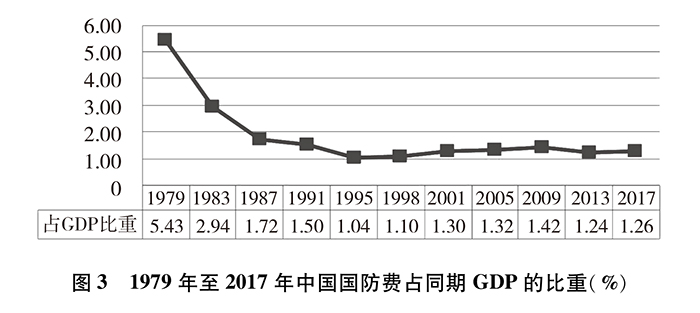
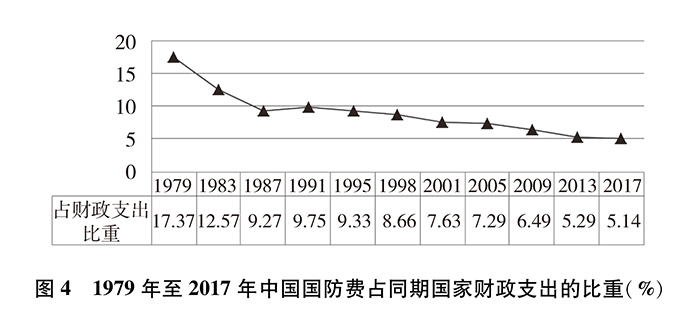
2012年以来中国国防费
China’s Defense Expenditure Since 2012
进入新时代,与国家现代化进程相一致,着眼建设与中国国际地位相称、与国家安全和发展利益相适应的巩固国防和强大军队,进一步缩小与世界先进军事水平的差距,解决军队打现代化战争能力不够的问题,中国国防费规模保持了稳步增长,支出结构持续优化。
In the new era, to keep pace with the country’s modernization, China is focusing on building a fortified national defense and a strong military commensurate with the country’s international standing, and its national security and development interests. China is striving to narrow the gap between its military and the world’s leading militaries, and make up the deficiencies in the military’s capabilities in modern warfare. Defense expenditure is growing steadily and the breakdown of spending is being continuously optimized.
中国国防费按用途划分,主要由人员生活费、训练维持费和装备费构成。人员生活费用于军官、文职干部、士兵和聘用的非现役人员,以及军队供养的离退休干部工资、津贴、伙食、被装、保险、福利、抚恤等。训练维持费用于部队训练、院校教育、工程设施建设维护以及其他日常消耗性支出。装备费用于武器装备的研究、试验、采购、维修、运输、储存等。国防费的保障范围包括现役部队、预备役部队、民兵等。
In terms of usage, China’s defense expenditure is assigned to three sectors – personnel, training and sustainment, and equipment. Personnel expenses mainly cover the salaries, allowances, food, bedding, clothing, insurance, subsidies and pensions for officers, non-ranking officers, soldiers and contracted civilians, as well as retirees supported from the defense budget. Training and sustainment expenses mainly cover training of the troops, institutional education, construction and maintenance of installations and facilities, and other expenditure on routine consumables. Equipment expenses mainly cover R&D, testing, procurement, repairs, maintenance, transport and the storage of weaponry and equipment. In terms of scope, defense expenditure covers all active forces, reserve forces and militia.
2012年以来增长的国防费主要用于:(一)适应国家经济社会发展,提高和改善官兵生活福利待遇,落实军队人员工资收入定期增长机制,持续改善基层部队工作、训练和生活保障条件。(二)加大武器装备建设投入,淘汰更新部分落后装备,升级改造部分老旧装备,研发采购航空母舰、作战飞机、导弹、主战坦克等新式武器装备,稳步提高武器装备现代化水平。(三)深化国防和军队改革,保障军队领导指挥体制、部队规模结构和力量编成、军事政策制度等重大改革。(四)保障实战化训练,保障战略训练、战区联合训练、军兵种部队训练等,加强模拟化、网络化、对抗性训练条件建设。(五)保障多样化军事任务,保障国际维和、护航、人道主义救援、抢险救灾等行动。
Since 2012, the increase in defense expenditure has been primarily spent for the following purposes:
1. Adapting to national economic and social development, improving the wellbeing of service personnel, ensuring regular increases in military salaries, and bettering the working, training and living conditions of the troops;
2. Increasing input in weaponry and equipment development, phasing out the outdated, upgrading the old, and developing and procuring the new, such as aircraft carriers, fighters, missiles and main battle tanks, to steadily modernize weaponry and equipment;
3. Deepening national defense and military reform, supporting major reforms in military leadership and command systems, force structure and composition, and policies and institutions;
4. Supporting training in real combat conditions, enhancing strategic-level training, joint training at TCs’ level and training of services and arms, and improving the conditions for simulated, networked and force-on-force training; and
5. Supporting diverse military tasks including the UNPKOs, vessel protection operations, humanitarian assistance operations and disaster relief efforts.
2012年至2017年,中国国防费从6691.92亿元人民币增加到10432.37亿元人民币。中国国内生产总值(GDP)按当年价格计算年平均增长9.04%,国家财政支出年平均增长10.43%,国防费年平均增长9.42%,国防费占国内生产总值平均比重为1.28%,占国家财政支出平均比重为5.26%。国防费占国内生产总值的比重稳定,与国家财政支出保持同步协调增长。
From 2012 to 2017, China’s defense expenditure increased from RMB669.192 billion to RMB1,043.237 billion. China’s GDP and government expenditure grew at average rates of 9.04% and 10.43% respectively, calculated on the price of the indicated years, while its defense expenditure increased by an average of 9.42%. Defense expenditure accounted for 1.28% of GDP and 5.26% of government expenditure on average. The percentage of China’s defense expenditure in GDP remained stable and grew in coordination with the increase of government expenditure.
中国国防费实行严格的财政拨款和预算管理制度。国防费使用坚持需求牵引、规划主导,坚持量入为出、量力而行,加强集中统管,统筹存量增量,逐步推行国防费绩效管理,推进以效能为核心的军费管理改革。改进和加强预算管理,深化军队资金集中收付制度改革,加快经费标准化建设步伐,完善军队资产资金管理办法。
China applies strict mechanisms of fiscal allocation and budget management on its defense expenditure. It pursues a level of defense spending that is demand-oriented, planning-led and consistent with its capacity. It endeavors to strengthen unified management, coordinate existing and incremental expenditure, gradually practice cost-effectiveness management, and steadily press ahead with reform that is centered on efficacy and efficiency. To improve and strengthen budget management, China’s armed forces are extending reform of the centralized collection and payment of military funds, accelerating standardization in relation to defense expenditure, and improving the management of assets and funds.
国防费的国际比较
Comparison of Defense Expenditure in the International Context
在2017年国防费位居世界前列的国家中,中国国防费无论是占国内生产总值和国家财政支出的比重,还是国民人均和军人人均数额,都处于较低水平。
Among countries ranking high in defense expenditure in 2017, China’s share of defense expenditure in GDP and government expenditure, as well as per capita and per-serviceperson defense spending, are all at a relatively low level.
中国已成为世界第二大经济体。国防费规模居于世界第二位,是由中国的国防需求、经济体量、防御性国防政策所决定的。从开支总量看,2017年中国国防费不到美国的四分之一。
China has become the world’s second largest economy. The fact that China’s defense expenditure ranks second in the world is determined by the demands of its national defense, the size of its economy, and the defensive nature of its national defense policy. In terms of total spending, China’s defense expenditure in 2017 was less than a quarter of that of the US.
从国防费占国内生产总值比重看,2012年至2017年,中国国防费占国内生产总值平均比重约为1.3%,美国约为3.5%、俄罗斯约为4.4%、印度约为2.5%、英国约为2.0%、法国约为2.3%、日本约为1.0%、德国约为1.2%。中国国防费占国内生产总值的平均比重在国防费位居世界前列的国家中排在第六位,是联合国安理会常任理事国中最低的。
As a percentage of GDP, from 2012 to 2017, China’s average defense expenditure was about 1.3%. Comparative figures were: the US about 3.5%, Russia 4.4%, India 2.5%, the UK 2.0%, France 2.3%, Japan 1.0%, and Germany 1.2%. China ranks 6th among these countries in terms of defense expenditure as a percentage of GDP on average and is the lowest among the permanent members of the UN Security Council (UNSC).
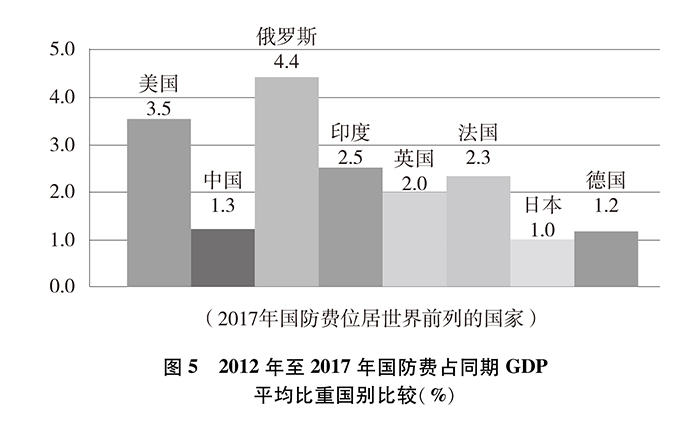
从国防费占财政支出比重看,2012年至2017年,中国国防费占财政支出平均比重约为5.3%,美国约为9.8%、俄罗斯约为12.4%、印度约为9.1%、英国约为4.8%、法国约为4.0%、日本约为2.5%、德国约为2.8%。中国国防费占财政支出的平均比重排在第四位。
As a ratio of spending to government expenditure, from 2012 to 2017, China’s average defense expenditure was 5.3%. Comparative figures were: the US about 9.8%, Russia 12.4%, India 9.1%, the UK 4.8%, France 4.0%, Japan 2.5%, and Germany 2.8%. China ranks 4th among these countries in terms of defense expenditure as a percentage of government expenditure on average.

从人均国防费水平看,2017年中国国民人均国防费为750元人民币,约相当于美国的5%、俄罗斯的25%、印度的231%、英国的13%、法国的16%、日本的29%、德国的20%。中国军人人均国防费为52.16万元人民币,约相当于美国的15%、俄罗斯的119%、印度的166%、英国的27%、法国的38%、日本的35%、德国的30%。中国国民人均国防费排在第七位,军人人均国防费排在第六位。
China’s per capita defense expenditure in 2017 was RMB750 – 5% of the US, 25% of Russia, 231% of India, 13% of the UK, 16% of France, 29% of Japan, and 20% of Germany. China’s per-serviceperson defense expenditure was RMB521,600 – 15% of the US, 119% of Russia, 166% of India, 27% of the UK, 38% of France, 35% of Japan, and 30% of Germany. China’s defense expenditure ranks 7th and 6th in per capita and per-serviceperson terms respectively among these countries.
中国坚持执行国防费报告和公布制度。1978年以来,中国政府每年向全国人大提交财政预算报告,并对外公布年度国防费预算总额。1995年,中国政府发布《中国的军备控制与裁军》白皮书,向世界公布国防费情况。2007年以来,中国参加联合国军费透明制度,每年向联合国提交上一财政年度国防费基本数据,按现役部队、预备役部队、民兵等类别,提交人员生活费、训练维持费、装备费三大类开支数额和国防费总额,并说明中国国防费的主要用途和占国内生产总值比重。
China reports and releases its defense expenditure through various mechanisms. Since 1978, the Chinese government has submitted annual budget reports to the National People’s Congress and released the total amount of defense budget. In 1995, the Chinese government issued a white paper, China: Arms Control and Disarmament, releasing data concerning its defense expenditure to the world. Since 2007, China has joined the UN Standardized Instrument for Reporting Military Expenditures and has submitted annually to the UN the basic data on its defense expenditure for the latest fiscal year, reporting total spending as well as personnel expenses, training and sustainment expenses, and equipment expenses for the active force, reserve force and the militia respectively, along with an explanation of the application of China’s defense expenditure and its ratio to GDP.
总体上看,中国国防费是公开透明的,开支水平是合理适度的,与世界主要国家相比,国防费占国内生产总值和财政支出的比重、人均国防费是偏低的。中国是世界上唯一尚未实现完全统一的大国,是世界上周边安全形势最复杂的国家之一,维护国家主权、领土完整、海洋权益等面临严峻挑战。中国日益走近世界舞台中央,国际社会对中国军队提供国际公共安全产品的期待不断增大。中国军队处于向信息化转型阶段,顺应世界新军事革命发展趋势、推进中国特色军事变革的任务艰巨繁重。中国国防开支与维护国家主权、安全、发展利益的保障需求相比,与履行大国国际责任义务的保障需求相比,与自身建设发展的保障需求相比,还有较大差距。中国国防开支将与国家经济发展水平相协调,继续保持适度稳定增长。
All in all, China’s defense expenditure is open and transparent, and its spending is reasonable and appropriate. Compared to other major countries, the ratios of China’s defense expenditure to GDP and to government expenditure, as well as the per capita defense expenditure of the country, remain at a relatively low level. As the only major country yet to be completely reunified, and one of the countries with the most complex peripheral security environment, China faces serious challenges in safeguarding national sovereignty, territorial integrity, and maritime rights and interests. China is moving closer to the center of the world stage, and the international community expects more international public security goods from the Chinese military. In addition, China’s armed forces are moving towards informationization and shouldering arduous tasks in following the trends of worldwide RMA and speeding up RMA with Chinese characteristics. There is still a wide gap between China’s defense expenditure and the requirements for safeguarding national sovereignty, security and development interests, for fulfilling China’s international responsibilities and obligations as a major country, and for China’s development. In step with national economic development, defense expenditure of China will maintain a moderate and steady growth.









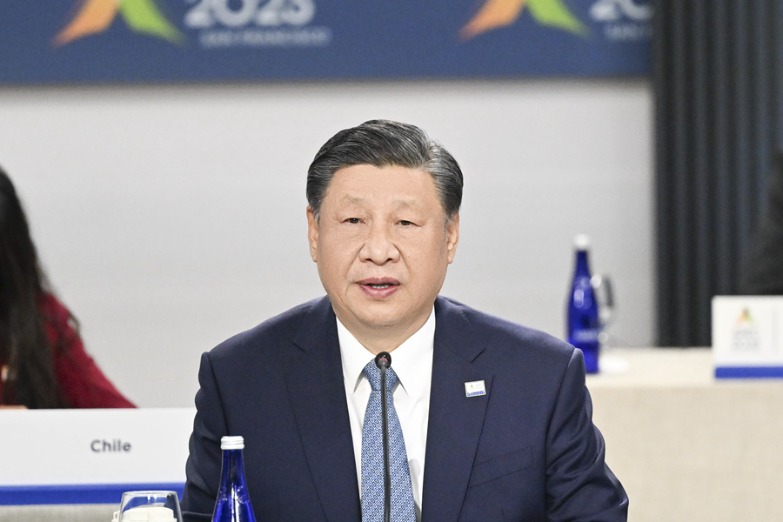

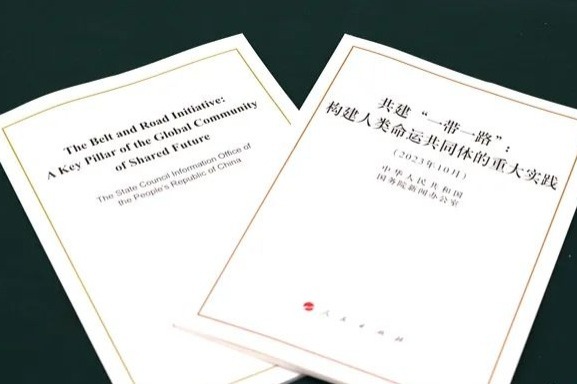
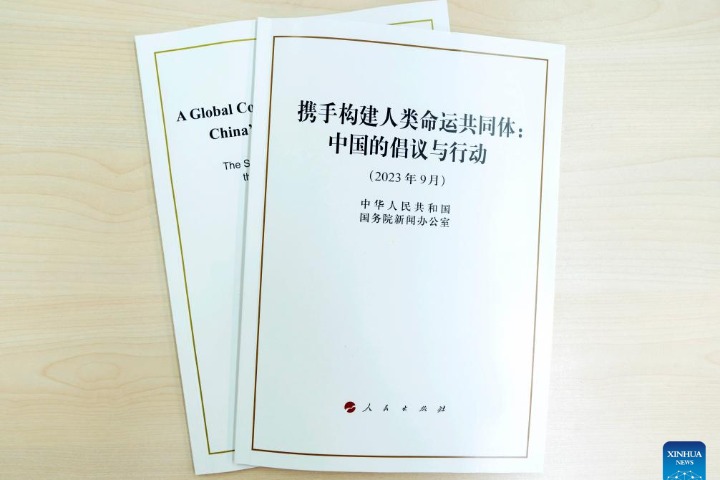
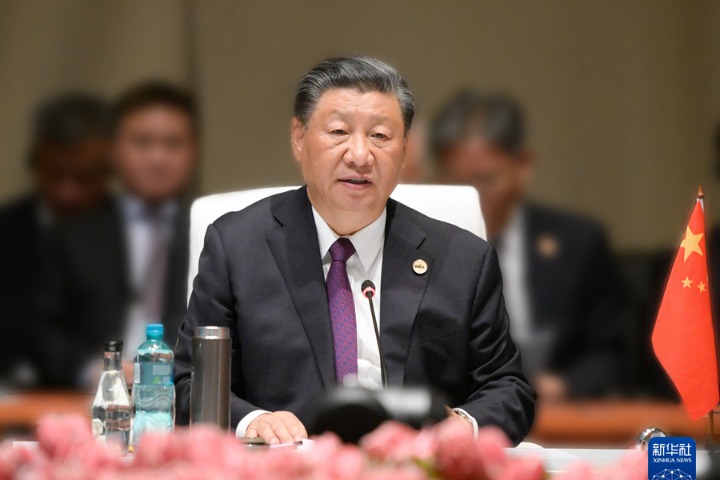



 英语点津微信
英语点津微信 双语小程序
双语小程序